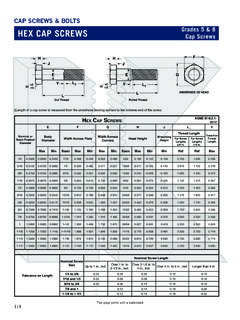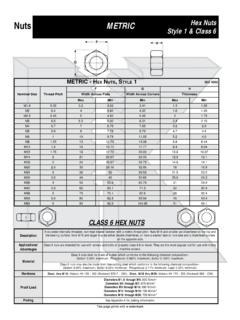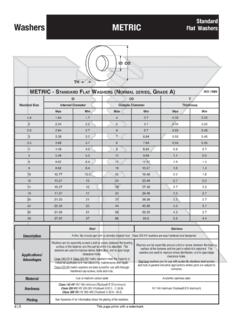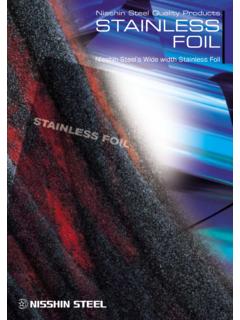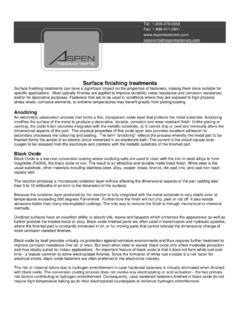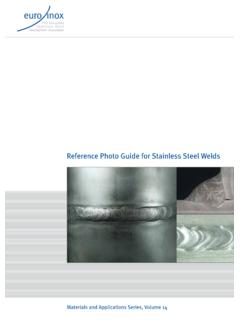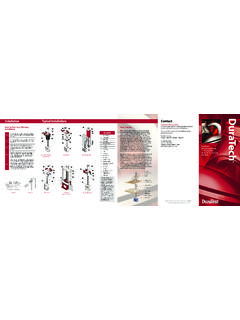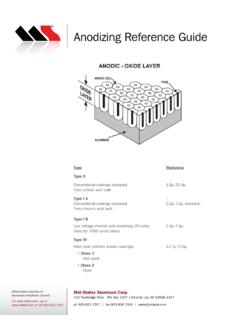Transcription of APPNI A PLATING - Screws-Nuts-Bolts
1 640 APPENDIX AFinishDescriptionElectro-Zinc & ClearZinc is the most popular of all commercial platings because it is relatively economical and offers good corrosion resistance in environments not subject to excessive moisture. To avoid any reduction in the strength properties of screws with Class 2A thread allowances in sizes No. 8 or smaller, a thinner zinc coating is acceptable. A clear or blueish chromate finish is applied on top of the zinc to provide additional protection against white oxidation spots which can form due to moisture. Electroplating is the most common way of applying zinc coatings to fasteners. It is recommended by certain industry experts that case-hardened parts which are electro-plated should be baked after PLATING to minimize the risk of hydrogen embrittlement (see below). Electro-Zinc & YellowYellow chromate offers a greater degree of protection from white corrosion than does clear chromate.
2 Electroplating is the most common way of applying zinc coatings to fasteners. Zinc Yellow to ASTM B633 The ASTM B633 standard was revised in 2007. One of the changes concerned the amount of time certain fasteners are baked to reduce the effects of hydrogen embrittlement. Prior to this revision, plated Grade-BD cap screws were required to be baked for at least 4 hours at a temperature of 190 C to 220 C. That revised standard calls for these parts to be baked for at least 10 hours at 190 C to 220 Coatings on Mechanical Fasteners to ASTM F1941 For fasteners manufactured after October 2015, this standard replaces ASTM B633. It addresses the topics of (a) thickness of zinc coating, (b) various chromate coatings, (c) baking requirements for fasteners with a core hardness over Rockwell C 39, and (d) salt-spray performance, as well as other standards.
3 For details re: the requirements this standard puts forth for the baking of through-hardened fasteners, see the following Zinc & BlackBlack chromate offers a similar appearance to black oxide but with greater degree of protection that black oxide lacks. Electroplating is the most common way of applying zinc coatings to & WaxA wax lubricant is added to the zinc coatings of certain fasteners to improve the ease of assembly. This is the standard PLATING for thread rolling screws including the Plastite and Taptite II, as well as two-way reversible center-lock nuts . Case-hardened parts are still recommended to be baked after PLATING (see below). Mechanical Zinc & ClearMechanically applying zinc to fasteners reduces the risk of hydrogen embrittlement forming within the parts. This minimizes the need for the precautionary practice of baking the parts soon after PLATING .
4 A clear or bluish chromate finish is applied on top of the zinc to provide additional protection against white oxidation spots, which can form due to moisture. It is common for lock washers made from spring steel to be plated this way to avoid brittleness after baking. Mechanical Zinc & YellowThis finish is identical to mechanical zinc but with a yellow chromate finish. This is the standard PLATING for high-alloy split lock washers and for tooth lock washers used with zinc yellow machine screws. Electro-Zinc & Clear for SocketsSocket cap screws can receive a zinc PLATING of inches thickness. A clear chromate finish is applied on top of the zinc to provide additional protection against white corrosion. The manufacturer must be told prior to the thread rolling process that the parts are to be plated. The plated parts are then baked at 375 F for 24 hours within one hour of PLATING then subjected to a 72-hour stress test.
5 Electro-Zinc & GreenCommercial zinc green is the finish applied to machine screws and thread-cutting screws that will be used a grounding screws in electrical applications. Electro-Zinc/Nickel Zinc/Nickel is selected to achieve the highest resistance to corrosion with the smallest thickness of protective coating. Typically, the nickel content of the alloy finish is 12-15%. The finish will withstand a minimum 1,000 hour Salt Spray RuspertA three-layer coating consisting of (1) a metallic zinc layer, topped with a (2) chemical conversion film layer, which is finally covered by a (3) baked ceramic surface coating. The finished parts have a dull silver color and will withstand a minimum of 1,000 hour Salt Spray has more of a silver color to it than zinc and has similar corrosion resistant characteristics. It is the standard finish of cap nuts , countersunk finishing washers, brass spacers and standoffs, as well as other parts to achieve a more decorative PLATING is sometimes used on parts in the food handling industry because it resists organic acid.
6 It improves the lubricity of steel and offers a high degree of corrosion resistance. SilverSilver is an excellent conductor of electricity. Its benefits are both decorative and protective as it resists thread galling when mated parts are under extreme pressure or exposed to extreme heat. PLATINGThis page prints with a watermark641 APPENDIX AFinishDescriptionCadmium & WaxCadmium PLATING results in a smoother surface and greater resistance to white oxidation spots than zinc PLATING . However, cadmium is a much more toxic metal than zinc, which makes the PLATING process more difficult and costly. The standard most commercial platers use when applying cadmium is a minimum thickness of .0002 inches. A supplemental wax coating is often added as a lubricant when cadmium is used on prevailing torque lock nuts . Hot-Dip GalvanizedHot dip galvanizing is generally the most effective way to apply a sufficient thickness of zinc to threaded fasteners for the zinc to serve as a corrosion protectant is harsh environments.
7 During the galvanizing process, steel reacts with molten zinc, forming layers of zinc-iron alloy layers, which are metallurgical bonded to the steel surface. This hard barrier has a low corrosion rate and resists mechanical damage. Bolts and nuts 3/8 inch diameter and smaller shall have a zinc coating with an average thickness of inches with no individual both having a coating of less than inches. Bolts and nuts over 3/8 inches diameter and all sizes if washers shall have a zinc coating with an average thickness of inches with no individual both having a coating of less than inches. Black PhosphateThis is the standard finish for most drywall screws, particle board screws and retaining rings. It can have either a dull or bright appearance. No additional oil treatment is required. Black Phosphate & OilThe most common standard coating of black phosphate and oil is 1100mg per , minimum.
8 The oil serves as a rust inhibitor and a lubricant. Some fasteners with this PLATING are required to pass a salt-spray test, the duration and cost of which must be agreed upon between buyer and seller prior to the sale. Floorboard screws, frame bolts, Grade-GT locknuts and spring nuts are usually supplied with a black phosphate and oil finish. Black OxideThis is a conversion coating which means it is formed by a chemical reaction with the metal to form an integral surface, as opposed to an applied coating like zinc which bonds to the metal. An oil finish is applied as a rust inhibitor. For more information about black oxide, see next page. ChromeChrome PLATING can be done in two ways: 1) A hard chrome finish deposits a thick layer of chrome on the part. This gives the fastener a very hard finish and superior wear resistance but does not offer much protection to corrosion; 2) A nickel-chrome finish is achieved by applying a flash of chrome on top of the nickel PLATING .
9 This offers resistance to tarnishing and corrosion. EcoGuard Provides a silver-gray color and an incredibly high level of corrosion resistance. Rated to withstand a minimum of 1,000-hour Salt Spray test. No risk for hydrogen embrittlement and is free of toxic is a pollution-free ceramic coating for fasteners used with treated lumber. The coating offers corrosion protection comparable to hot-dip galvanizing without discoloring the wood. Screws with a proper dacro coating can typically withstand a 500-hour salt-spray test. A dacro finish minimizes greatly the risk of hydrogen embrittlement so baking the part is not required after the finish is applied. Blue RuspertRuspert metal finish is a high-quality corrosion-resistant coating that is comprised by three layers: (1) metallic zinc; (2) a chemical conversion film (to resist corrosion); and (3) a ceramic surface coating that is baked.
10 Antique BrassThis is a brass finish that has been chemically darkened to appear similar to aged brass--a moderate brown color with golden hues. It is common in cabinet BrassBright brass is strictly a decorative finish that is commonly used with cabinet hardware. It offers minimal resistance to corrosion but will not stain when used in acidic finish is also a barrier coating used to offer corrosion resistance. It is used, through not exclusively, on certain types of construction fasteners and typically provides over 500 salt spray hours or more of protection. Green ceramic is a common finish for cement board screws. Flat head deck screws are available in multiple colors of ceramic finish including green, red and / BAKING / PASSIVATINGB aking of Case Hardened PartsElectroplated screws, which are case hardened, should be baked for a minimum of 4 hours within the temperature range of 375-450 F no later than 4 hours after the PLATING operations.

